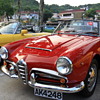Posted 11 years ago
 cwpost
cwpost
(122 items)
The image displayed is that of an early or mid 19th century spice chest.
It has all the characteristics of an salesman sample and or miniature furniture. The chest is made of mahogany an is off it's original surface with it's original wooden pulls. Measuring 18 x 14 1/2 x 11 3/4 inches, it has five dovetail drawers.
History tells us that spice boxes were used in England in the 17th and 18th centuries and the form followed the colonists to the New World. She does not explain, however, why the spice boxes fell from fashion in New England by the second decade of the 18th century, but notes that they continued to be made in Pennsylvania throughout the 18th century.
Spice boxes did not appear in every household, only those that were well furnished and fairly prosperous. They were generally part of the parlor furniture; Griffith found no evidence that they were ever kept in the kitchen. They were used for the storage of valuable jewelry, silver spoons, gold buttons, silver shoe buckles, ivory combs, spectacles, pincushions or a piece of lace as well as nutmeg, cloves, ginger and allspice. They were shared by husband and wife.
Some household inventories from colonial times list a spice box immediately following a table, chest or desk, suggesting that they were kept on top of larger pieces of furniture.
The spice box was a luxury item made of high quality woods and decorated with fine inlay. Considerable skill was required to design and construct the intricate interior drawer arrangements; some were miniaturizations of high chests of drawers.
The arrangement of the interior drawers generally follows two general patterns. The most common is a symmetrical configuration around a square center drawer similar to English valuables cabinets and 17th century New England spice cabinets. The alternative arrangement is a bank of graduated drawers. Spice boxes with dates inlaid, made in Chester County in the 1740s, all have arrangements of graduated drawers and many are equipped with secret drawers and special locking systems.
Some drawers have false bottoms or false backs that conceal a secret compartment; large cornice moldings often contain a secret drawer. Drawers were sometimes fitted with ``Quaker locks.`` A Quaker lock consists of a thin splint of wood nailed into the bottom of the drawers that caught on the drawer divider and prevented the drawer from being pulled open.













